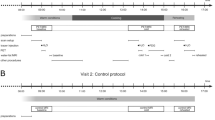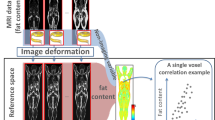Abstract
Upper body abdominal subcutaneous adipose tissue (SAT) can be divided into deep SAT (DSAT) and superficial SAT (SSAT) depots. Studies on adipose tissue fatty acid (FA) composition have made no distinction between these two depots. The aim of this study is to determine whether DSAT and SSAT differ in FA composition. We studied the FA composition of DSAT and SSAT in 17 male and 13 female volunteers using non-invasive proton magnetic resonance spectroscopy in vivo. Magnetic resonance imaging was used to differentiate between DSAT and SSAT. Adipose tissue spectra were analysed for lipid unsaturation, or double bond (DB) content, and polyunsaturation (PU), according to previously validated methods. The DSAT depot was more saturated than the SSAT depot, in both men (0.833±0.012 vs 0.846±0.009 DB, P<0.002) and women (0.826±0.018 vs 0.850±0.018 DB, P<0.002). In contrast, PU did not differ between DSAT and SSAT in either men (0.449±0.043 vs 0.461±0.044 PU, P=0.125) or women (0.411±0.070 vs 0.442±0.062 PU, P=0.234) and displayed a close correlation between the depots (R=0.908, P<0.001, n=30). The higher saturation in DSAT compared with SSAT can be attributed to a higher ratio of saturated to monounsaturated FAs. These results should be taken into account when determining the FA composition of SAT.
This is a preview of subscription content, access via your institution
Access options
Subscribe to this journal
Receive 12 print issues and online access
$259.00 per year
only $21.58 per issue
Buy this article
- Purchase on Springer Link
- Instant access to full article PDF
Prices may be subject to local taxes which are calculated during checkout


Similar content being viewed by others
References
Seidelin KN . Fatty acid composition of adipose tissue in humans. Implications for the dietary fat-serum cholesterol-CHD issue. Prog Lipid Res 1995; 34: 199–217.
Markman B, Barton FE . Anatomy of the subcutaneous tissue of the trunk and lower extremity. Plast Reconstr Surg 1987; 80: 248–254.
Monzon JR, Basile R, Heneghan S, Udupi V, Green A . Lipolysis in adipocytes isolated from deep and superficial subcutaneous adipose tissue. Obes Res 2002; 10: 266–269.
Lancerotto L, Stecco C, Macchi V, Porzionato A, Stecco A, De Caro R . Layers of the abdominal wall: anatomical investigation of subcutaneous tissue and superficial fascia. Surg Radiol Anat 2011; 33: 835–842.
Walker GE, Verti B, Marzullo P, Savia G, Mencarelli M, Zurleni F et al. Deep subcutaneous adipose tissue: a distinct abdominal adipose depot. Obesity 2007; 15: 1933–1943.
Hodson L, Skeaff CM, Fielding BA . Fatty acid composition of adipose tissue and blood in humans and its use as a biomarker of dietary intake. Prog Lipid Res 2008; 47: 348–380.
Sjögren P, Sierra-Johnson J, Gertow K, Rosell M, Vessby B, de Faire U et al. Fatty acid desaturases in human adipose tissue: relationships between gene expression, desaturation indexes and insulin resistance. Diabetologia 2008; 51: 328–335.
Roberts R, Hodson L, Dennis A, Neville M, Humphreys S, Harnden K et al. Markers of de novo lipogenesis in adipose tissue: associations with small adipocytes and insulin sensitivity in humans. Diabetologia 2009; 52: 882–890.
Deschênes D, Couture P, Dupont P, Tchernof A . Subdivision of the subcutaneous adipose tissue compartment and lipid-lipoprotein levels in women. Obes Res 2003; 11: 469–476.
Kelley DE, Thaete FL, Troost F, Huwe T, Goodpaster BH . Subdivisions of subcutaneous abdominal adipose tissue and insulin resistance. Am J Physiol Endocrinol Metab 2000; 278: E941–E948.
Koska J, Stefan N, Votruba SB, Smith SR, Krakoff J, Bunt JC . Distribution of subcutaneous fat predicts insulin action in obesity in sex-specific manner. Obesity 2008; 16: 2003–2009.
Lundbom J, Hakkarainen A, Fielding B, Söderlund S, Westerbacka J, Taskinen M et al. Characterizing human adipose tissue lipids by long echo time 1H-MRS in vivo at 1.5 Tesla: validation by gas chromatography. NMR Biomed 2010; 23: 466–472.
Vanhamme L, van den Boogaart A, Van Huffel S . Improved method for accurate and efficient quantification of MRS data with use of prior knowledge. J Magn Reson 1997; 129: 35–43.
Lundbom J, Hakkarainen A, Söderlund S, Westerbacka J, Lundbom N, Taskinen MR . Long-TE (1)H MRS suggests that liver fat is more saturated than subcutaneous and visceral fat. NMR Biomed 2011; 24: 238–245.
Lundbom J, Heikkinen S, Fielding B, Hakkarainen A, Taskinen MR, Lundbom N . PRESS echo time behavior of triglyceride resonances at 1.5T: detecting omega-3 fatty acids in adipose tissue in vivo. J Magn Reson 2009; 201: 39–47.
Votruba SB, Jensen MD. . Regional fat deposition as a factor in FFA metabolism. Annu Rev Nutr 2007; 27: 149–163.
Frayn KN . Adipose tissue as a buffer for daily lipid flux. Diabetologia 2002; 45: 1201–1210.
Smith SR, Lovejoy JC, Greenway F, Ryan D, deJonge L, de la Bretonne J et al. Contributions of total body fat, abdominal subcutaneous adipose tissue compartments, and visceral adipose tissue to the metabolic complications of obesity. Metabolism 2001; 50: 425–435.
Acknowledgements
This work has been funded by the Sigrid Juselius Foundation, the Finnish Foundation for Cardiovascular Research, Instrumentarium Research Foundation and the Helsinki University Central Hospital: a special governmental subsidy for health sciences research (TYH7256).
Author information
Authors and Affiliations
Corresponding author
Ethics declarations
Competing interests
The authors declare no conflict of interest.
Rights and permissions
About this article
Cite this article
Lundbom, J., Hakkarainen, A., Lundbom, N. et al. Deep subcutaneous adipose tissue is more saturated than superficial subcutaneous adipose tissue. Int J Obes 37, 620–622 (2013). https://doi.org/10.1038/ijo.2012.72
Received:
Revised:
Accepted:
Published:
Issue Date:
DOI: https://doi.org/10.1038/ijo.2012.72
Keywords
This article is cited by
-
Body composition and cancer survival: a narrative review
British Journal of Cancer (2024)
-
Abdominal adipose tissue and liver fat imaging in very low birth weight adults born preterm: birth cohort with sibling-controls
Scientific Reports (2022)
-
Depot-specific differences in fatty acid composition and distinct associations with lipogenic gene expression in abdominal adipose tissue of obese women
International Journal of Obesity (2017)
-
Automated analysis of liver fat, muscle and adipose tissue distribution from CT suitable for large-scale studies
Scientific Reports (2017)
-
Relationship between deep subcutaneous abdominal adipose tissue and metabolic syndrome: a case control study
Diabetology & Metabolic Syndrome (2016)



